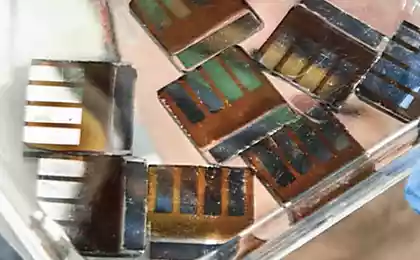670
Russian scientists have found a way to improve the work supercanine battery
Scientists from MIPT and a number of Russian and foreign universities has revealed how the electrons move in the perovskite, an unusual natural material, which can be the basis for ultra-efficient solar future.

"These compounds are extremely interesting physical properties, the most famous of which is the colossal magnetoresistance. Despite the fact that manganites have been actively studied for decades, many of their properties remain a mystery. In our article we tried to find the answer to one of these mysteries, namely what is the mechanism of conduction of one of the perovskites," said Boris Gorshunov from the Moscow physics and technology in Dolgoprudnyy, quoted in the press service of MIPT.
In recent years, scientists have created several exotic materials to increase the solar cell efficiency several times. In particular, the attention of physicists increasingly attracts the mineral perovskite and its synthetic analogs, thin films are semiconductors, well convert the energy of light into electricity.

Most light-absorbing materials have a symmetrical crystal structure, which allows electrons to flow freely in different directions. Perovskite has a cubic crystal lattice formed by atoms of one metal. Inside each cube is an octahedron formed by oxygen atoms, inside of which sits an atom of another metal.
The interaction between the atoms causes the electrons to flow in a single direction, thanks to which solar batteries on the basis of the perovskite has a very high efficiency of about 12-15%. A team of Russian and foreign scientists under the leadership Gorshunova found a way to improve the properties of perovskite find that they are an unusual type of conductivity, associated with the so-called polaron.

A polaron is an electron that when distributing shifts ions of the crystal lattice from their own field – he "bends" the crystal, acting in response to the electron. Perovskites with its almost perfect structure, great for the occurrence of such pairs of "crystal-electron".
The discovery of the mechanism of conductivity in perovskites, as scientists hope, will help to further study their properties and the establishment of the first commercial devices based on these minerals. For example, there is already a prototype of a highly efficient and cheap installation for the separation of water into oxygen and hydrogen, based on perovskites. In addition, the perovskites can be used to create efficient LEDs, but so far they only work at temperatures of liquid nitrogen. published
P. S. And remember, only by changing their consumption — together we change the world! ©
Source: ria.ru/science/20160622/1449684848.html#ixzz4CNziXYCF

"These compounds are extremely interesting physical properties, the most famous of which is the colossal magnetoresistance. Despite the fact that manganites have been actively studied for decades, many of their properties remain a mystery. In our article we tried to find the answer to one of these mysteries, namely what is the mechanism of conduction of one of the perovskites," said Boris Gorshunov from the Moscow physics and technology in Dolgoprudnyy, quoted in the press service of MIPT.
In recent years, scientists have created several exotic materials to increase the solar cell efficiency several times. In particular, the attention of physicists increasingly attracts the mineral perovskite and its synthetic analogs, thin films are semiconductors, well convert the energy of light into electricity.

Most light-absorbing materials have a symmetrical crystal structure, which allows electrons to flow freely in different directions. Perovskite has a cubic crystal lattice formed by atoms of one metal. Inside each cube is an octahedron formed by oxygen atoms, inside of which sits an atom of another metal.
The interaction between the atoms causes the electrons to flow in a single direction, thanks to which solar batteries on the basis of the perovskite has a very high efficiency of about 12-15%. A team of Russian and foreign scientists under the leadership Gorshunova found a way to improve the properties of perovskite find that they are an unusual type of conductivity, associated with the so-called polaron.

A polaron is an electron that when distributing shifts ions of the crystal lattice from their own field – he "bends" the crystal, acting in response to the electron. Perovskites with its almost perfect structure, great for the occurrence of such pairs of "crystal-electron".
The discovery of the mechanism of conductivity in perovskites, as scientists hope, will help to further study their properties and the establishment of the first commercial devices based on these minerals. For example, there is already a prototype of a highly efficient and cheap installation for the separation of water into oxygen and hydrogen, based on perovskites. In addition, the perovskites can be used to create efficient LEDs, but so far they only work at temperatures of liquid nitrogen. published
P. S. And remember, only by changing their consumption — together we change the world! ©
Source: ria.ru/science/20160622/1449684848.html#ixzz4CNziXYCF
Beach house Carla Fendi is the imagination and lack of stereotypes
Developed hybrid nanogenerator, collecting ocean energy























